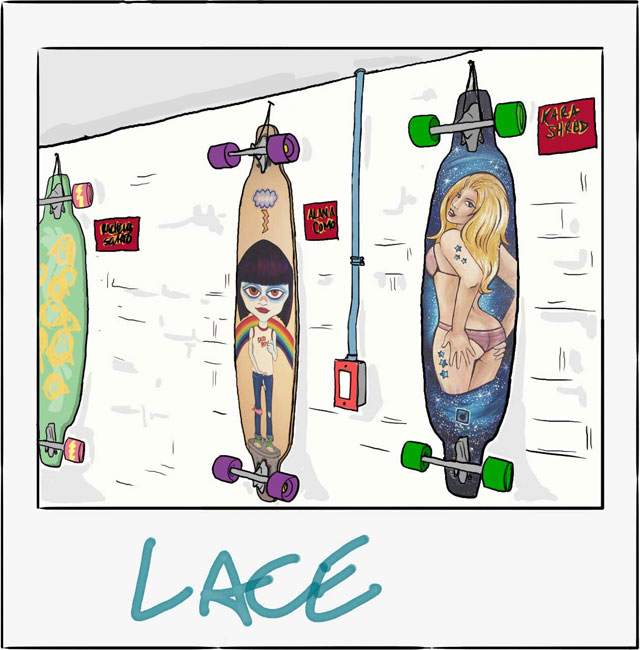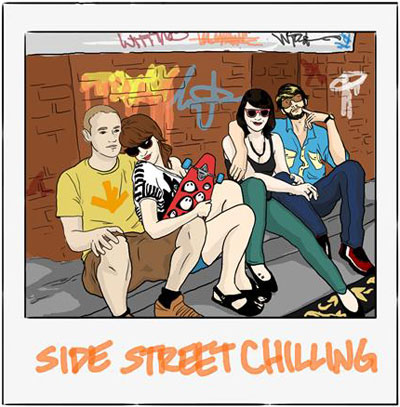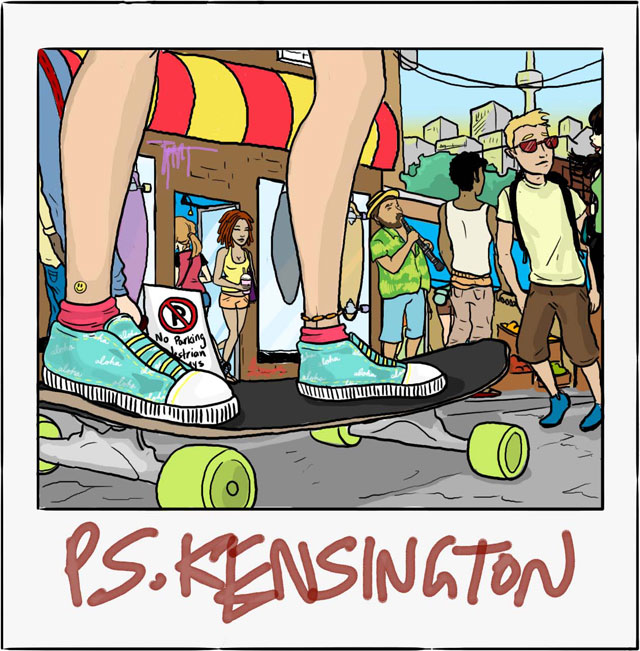
Words by Drew Penner, illustrations by Rachelle Scarfó
For many here in Toronto, it has become a bit of a tradition to descend on the hypercultural Kensington Market district on the last weekend of every month for Pedestrian Sundays, a street festival celebrating life beyond car culture. On May 30, during the first “P.S. Kensington” event of the year, the city’s bloggers, fashionistas and musicians were out in full force. Roads were closed to vehicles for the day as revelers packed the streets, sipping on organic fruit cocktails, observing magic shows and dancing in impromptu drum circles.
A few doors down from the heart of the action, an art show with its own take on activism was in session. It was the perfect moment to make a statement.
Showcasing the work of 15 female artists, the Longboard Artist Collective and Exhibition (LACE) exhibition at Longboard Living used a popular mode of clean transportation – the longboard – as a tool to buck the traditional male-dominated nature of both the art world and the boardsport industry.
“It starts with an idea, and it ends at the 11th hour – that’s when the energy really begins to flow,” said Longboard Living gallery owner Ryan Rubin, sitting on the steps outside his shop, the din of funk music somewhere off in the background. “It came together nicely.”
The independent show was inspired by an article in the pages of Cooler’s Aug/Sept 2009 edition (Issue 20) about The Decked Project, an exhibit held last August in London that promoted the work of female artists.
While The Decked Project featured a third of the pieces created by women, LACE was a grassroots effort entirely made up of female artists. Rubin explains he wanted to challenge the perception that women can’t man-up. “There was a lot of demand from female artists to make this happen,” he said. “We wanted to completely flip the script.”
 Lisa Farrows, a Longboards by Fatboy team rider who had several custom longboards on display in the show, thinks the gallery helped open people’s eyes. “It’s great that Ryan did an all-girls show, because we need recognition from all sides,” she said. “Throughout history traditionally women have been held back, and they’ve made progress in leaps and bounds.” Farrows stresses that, to her, board art is about quality first and foremost. “Would I buy a deck because it was created by a woman?” she asked. “If I liked the graphic, maybe. But would it be the sole basis? Not really.”
Lisa Farrows, a Longboards by Fatboy team rider who had several custom longboards on display in the show, thinks the gallery helped open people’s eyes. “It’s great that Ryan did an all-girls show, because we need recognition from all sides,” she said. “Throughout history traditionally women have been held back, and they’ve made progress in leaps and bounds.” Farrows stresses that, to her, board art is about quality first and foremost. “Would I buy a deck because it was created by a woman?” she asked. “If I liked the graphic, maybe. But would it be the sole basis? Not really.”
There’s no surprise that artists, activists and extreme sports enthusiasts are tired of seeing women underrepresented in the art gallery and the skate shop. However, the outlook is quite optimistic these days.
The art world was abuzz the past few months after it was announced, for the first time in history, more than half of the artists in one of the year’s most significant art shows, the Whitney Biennial, would be women.
Longboarding, too, represents a unique opportunity to close the gender gap. After all, women are flocking to the sport in record numbers. According to Erik Basil, head of sliverfishlongboarding.com, one of the world’s busiest skate-related websites, clocking 19,000 unique visitors a day, “Longboarding, as an aspect of skateboarding is less ‘male dominated’ in terms of participation than is street and vert skating. In fact, at the college-age level, it’s pretty much about 50/50 in many places.”
But even with longboarding, there’s a big hill to climb. “In some aspects of longboarding, such as speedboard racing, although the women’s divisions are active, very competitive and growing, they’re about 10 per cent of the registered racers,” he adds.
Gary Fluitt, president of slalomskateboarder.com, calls the longboarding industry a “very male dominated industry in all facets, including artwork and design. Out of 100 longboarders in a recent local downhill race, I counted three ladies.”
Yet, from groundbreaking female riders and artists like Sharma Yarwenko, who runs Slow Motion Longboards, to Pam Zoolalian, a former X-Games street luger who is now the senior designer at skate company Skatera, there are a lot of women out there making their mark on the boardsport graphic design industry.
But even these modern trailblazers are standing on the shoulders of giants. “For the last 30 years women artists have been saying, ‘We need more recognition,’” states Syrus Ware, a coordinator at the prestigious Art Gallery of Ontario. “It’s still an issue today.”
Ware says it’s important to remember that though this year’s Whitney Biennial exhibition in New York has been referred to as the “the women’s biennial”, back in 1970 Faith Ringgold and the Ad Hoc Women’s Art Committee led a two-and-a-half month protest to fight chronic underrepresentation in the very same gallery.
Vicky Newman, co-founder of The Decked Project, the yearly gallery initiative that inspired Toronto’s LACE exhibit, agrees that women have a lot to contribute to boardsport art. “I think the future is more about diversity than just ‘mainstream,’” she said. “I think that’s where a female perspective can really help.”

Even so, there are a lot of little things that need to be tweaked to grab the interest of the average girl out there. According to Newman, the violent imagery in a lot of board art for example is meant to entice the stereotypical male consumer. “There needs to be more boards that would appeal to women, instead of catering to a purely masculine demographic.”
Yet each small step is a big opportunity. After a weeklong show in London, The Decked Project headed to Canterbury, giving the female artists involved the opportunity to show right next to renowned street artist Banksy. “We wanted to celebrate young artists by allowing them to exhibit alongside established artists,” Newman explained. If nothing else, the curators of The Decked Project can put a feather in their caps for inspiring a compelling community skate show on the other side of the globe.
For the ladies of LACE, the concept of an all-girl art show wasn’t a gimmick. “I don’t feel like art needs to be categorized by gender, although it might look more feminine,” states 23-year-old Alana Como, exhibiting an untitled longboard featuring an image of a young rascal with a finger extended from the groin area, possibly the lovechild of a Rugrat and Salad Fingers. “I like doing artwork that challenges the conventions of normalcy.”
Nineteen-year-old Elly Chang exhibited a board featuring a composite painting of New York, Toronto and Shanghai, priced at $350. “I was just so psyched about this opportunity to get my art out,” she rejoiced.
Echoing the “stoke” embraced by many longboarders, she says her art represents a desire to take control of her environment. “You make the city into your own personal landscape.”
Channeling the laid back activism of Pedestrian Sundays, the LACE exhibit at Longboard Living proved that women aren’t afraid to have a good time creating board art with a message. “We just want to show what we’re capable of,” adds exhibiting artist Sidney Cohen. “You know? Girls can be badass and paint on longboards. We’re just bringing it.”





